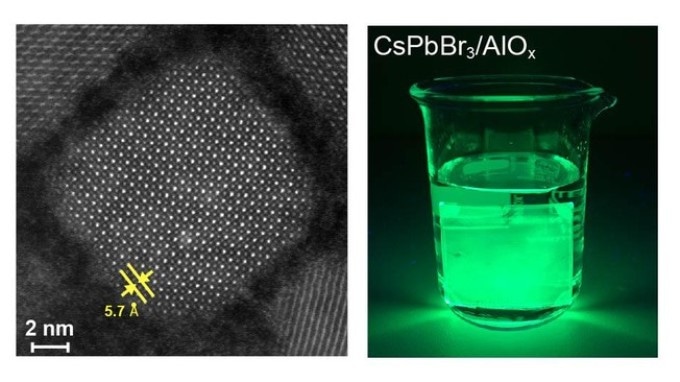May 30 2017
 Electron microscopy image of perovskite quantum dots embedded in the protective alumina matrix, and a photograph of the same film stable in water © R. Buonsanti/EPFL
Electron microscopy image of perovskite quantum dots embedded in the protective alumina matrix, and a photograph of the same film stable in water © R. Buonsanti/EPFL
EPFL researchers have created a new type of inorganic nanocomposite that enables perovskite quantum dot to be remarkably stable against air exposure, heat, sunlight, and water.
Quantum dots can be defined as nanometer-sized, semiconducting materials whose miniature size gives them novel optical properties. A lot of effort has been put into constructing quantum dots from perovskites, which already display much potential for solar panels, laser technologies, and LEDs. Their vital optoelectronic properties are also highly unique and of huge interest among the scientists. However, perovskite quantum dots have major issues with stability against air, light, heat, and water. The EPFL team has at present succeeded in designing perovskite quantum dot films with a method that helps them overcome these issues. The research findings have been published in Angewandte Chemie.
The new method to stabilize the perovskite quantum dots was formulated in the lab of Raffaella Buonsanti at EPFL Valais Wallis. The innovation of this research, created by Anna Loiudice and PhD student Seryio Saris, lies in a method known as “atomic layer deposition” (ALD), which is typically used to make ultra-thin films with high uniformity in their structure. The idea was to apply ALD to encapsulate the perovskite quantum dots with an amorphous alumina matrix, which serves as a gas and ion diffusion barrier thereby making the quantum dots sturdier against air, heat, light, and moisture.
The team used an assortment of characterization methods to monitor the nucleation and growth process of the alumina matrix on the quantum dot surface. The process revealed that the interaction between the ALD precursor and the dot surface is critical in order to evenly coat the dots while safeguarding their optoelectronic properties.
“By addressing the stability challenge of perovskite quantum dots, this work is expected to greatly impact the field by enabling fundamental optoelectronic studies, which require the samples to be stable during the measurements, in addition to increase the durability of devices based on this new class of quantum dots,” say the authors.
This research received assistance from EPFL’s Interdisciplinary Centre for Electron Microscopy. It was funded by a Horizon 2020-Marie Curie Individual Fellowship and the Swiss National Science Foundation.
Reference
A. Loiudice, S. Saris, E. Oveisi, D. T. L. Alexander, R. Buonsanti. CsPbBr3 QD/AlOx inorganic nanocomposites with exceptional stability in water, light, and heat. Angewandte Chemie 26 May 2017. DOI: 10.1002/anie.201703703